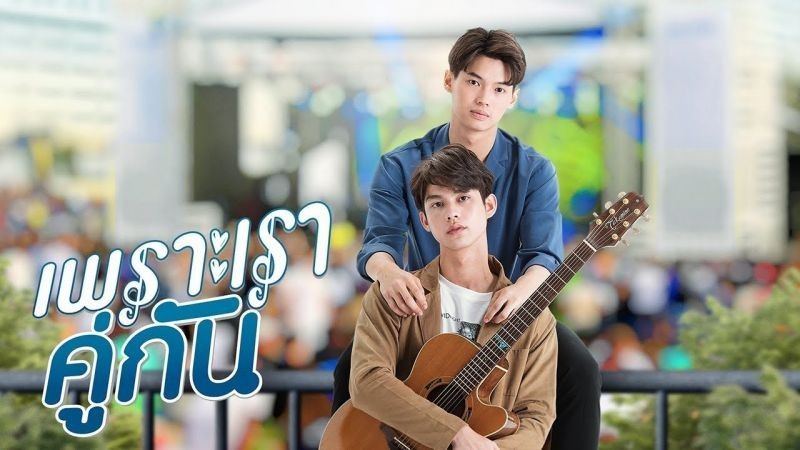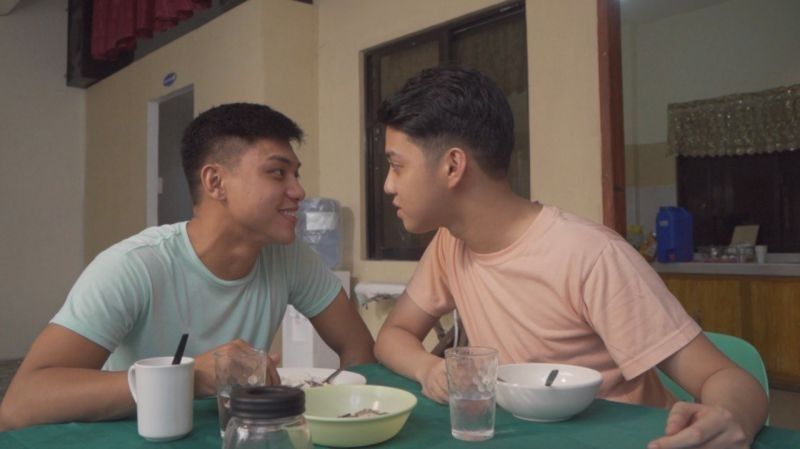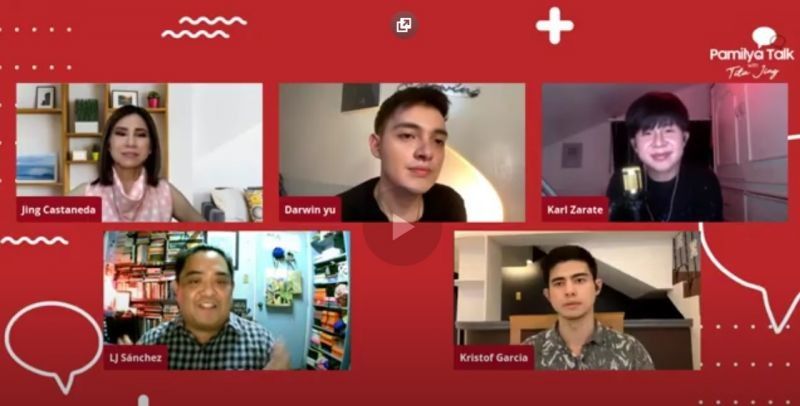Explaning BL and GL shows to children
You’re in the living room and you catch one of your teenagers casually on her smartphone, watching two guys her age exchange sweet nothings. You find out it’s a romantic show centering on these two guys who now turn out to be successful superstars in real life—all thanks to a material fast tallying millions of views online and counting.
Your daughter finally clues you in, “Mom, it’s BL.”
It’s an entirely new scenario to some parents, but not to me who got familiarized with the “boy’s love” genre or BL thanks to my own daughters. The curious mom that I am, I have watched my first BL: "My Dear Loser: Edge of 17" next to my teenagers, Fiana, Fiona, and Fae. I would later listen to my girls getting kilig and obsessing over the mega-popular Thai series 2gether, which they then followed with their Filipino BL “favorites” Gameboys and Gaya Sa Pelikula. I would notice their excitement every time they talked about these shows, featuring guys being intimate and with girls only in the background.
Each conversation was definitely interesting, a far cry from the time when my own parents would cover my eyes with their hands whenever a guy and a girl kissed on primetime TV. Back then, my family would sit around the TV set altogether as each show turned more mature in theme as the night progressed. And if by some slim chance my siblings and I glimpsed a non-GP scene, Mommy and Daddy had some awkward but careful explaining to do.
Today’s world is obviously not the same. Because of these readily available streaming sites and apps, our kids these days now have the option which film or series to watch—including which genre, director, writer, or leading star that interest them. My daughters following a BL series illustrate just that. In our past discussions, plus our recent Pamilya Talk episode featuring BL personalities and relevant queer experts, it was this tita being humbly schooled about what new, revolutionary online content like BL could do.
The roots of BL
BL as a genre started in Japan’s 1970s comic scene. Amid male manga writers creating female characters targeted to fellow men that time, female artists started developing their own fictional males that they themselves would read. BL was then formally called yaoi (BL-themed stories by women and for women).
BL would eventually expand into anime and motion picture. It has recently grown a market in other Asian countries including Thailand, which then launched some of the most successful BL novels turned series. These Thai shows would find itself onto the Filipinos’ screens especially during last year’s lockdown period. One of which was the aforementioned 2gether starring Bright Vachirawit and Win Metawin—ABS-CBN’s Kapamilya Channel even tagalized the series for its audience last year.
The BL following in the Philippines got past being a fad rather quickly, with many local studios later producing BL films one after the other. Among these projects, there were Hello Stranger, Quaranthings, and my daughters’ own recos, Gameboys and Gaya sa Pelikula. The overwhelming reception made these instant hits online, launching the careers of newbies-turned-household names like JC Alcantara, Royce Cabrera, Kokoy de Santos, Elijah Canlas, Paolo Pangilinan, and Ian Pangilinan. This, while giving a different edge to formerly mainstream actors like Tony Labrusca, Alex Diaz, and Jerome Ponce, who have also starred in BL films and series on their career detour.
In my show, I got to chat with BL actors Darwin Yu (My Extraordinary), Karl Zarate (Quaranthings), and Kristof Garcia (Kumusta, Bro?) who have also tasted their career highs following BL’s impact. The fandom will only grow with more BL offerings in the pipeline, I’ve been told.
Of love and family in BL
Coming from a journalist who believes in a dynamic media, BL is an entire universe altogether of new, exciting content. But as a parent witnessing her kids learn valuable life lessons through this genre, it’s even more a poignant discovery.
BL isn’t just about two good-looking binatilyos being cutesy around each other, pop culture expert Louie Jon Sanchez Ph.D. explained. Pinoy BL, he stressed, carries universal themes and concepts formerly left only to our most beloved primetime dramas featuring heterosexual couples. This formula sees why the BL fan composition in our country consists mostly of the LGBTQIA+ community, whose many members may have had internal struggles living in a truly religious, conservative, family-oriented setting.

“Sa teleserye, important ang family. Pero pag tinignan mo ang mga Pinoy BL na lumabas, lagi silang may aspect ng family. Ibang-iba sya sa mga BL na napapanood natin sa Thailand o nababasa natin sa Japan.”
“Napakahalaga ng family sa coming of age o coming out of the closet. Napaka-important na andun ang pamilya kasi karaniwan sa mga nakikita natin sa BL ay mga pamilyang bukas ang isip,” added the Ateneo de Manila professor.
Besides bullying, insecurities, and other issues and crimes, struggles in sexual orientation among the youth has always been a major factor behind their mental health decline, trauma, and even death. In The Trevor Project’s recently released National Survey on LGBTQ Youth Mental Health, 42% of 35,000 American respondents aged 13-24 considered suicide attempts in the past 12 months. More than half of them identified as trans or nonbinary (neither male or female), the NGO reported.
Back at home, it’s also not easy. The LGBTQIA+ community and its allies in the Philippines cry desperately against unfazed institutions, despite considerable improvements in markets and mindset. In 2018, the Philippine Corporate SOGIE (Sexual Orientation and Gender Identity Expression) Diversity and Inclusiveness Index reported that not one out of 100 Philippine-based companies implemented policies aimed to protect employees from SOGIE-related discrimination. Of note, the SOGIE Bill or Anti-Discrimination Bill, seeking to grant the LGBTQIA+ equal rights and protection, carries on as the longest running bill under Senate interpellation.

It’s still a long way to go locally. But hopefully with the help of more gender-inclusive material like BL making it on mainstream media, Sanchez believes the level of awareness and interest about SOGIE will only grow.
“May kinalaman dyan yung paglawak ng platforms—where to talk about it, where to watch the stories,” he said.
After all, BL’s only major ‘difference’ from the usual heteronormative offerings is queer characters at front and center. Quaranthings director Pancho Maniquis, who also guested on “Pamilya Talk,” maintains that every BL project—or even that of the newer genre GL/Girl’s Love—conveys the same message of love and acceptance.
“More than creating stories, it’s about giving a voice to the (LGBTQIA+) community and giving proper representation. Finally, may spotlight na to be able to tell these stories. For so long and we all know this—in the media, queer roles or gay roles—lagi silang comic relief, pang-fun at kwela lang,” Maniquis said. “Gusto nating mailihis ang pagiging caricature and stereotypes ng gay roles sa film industry and sa mga series.”
Maniquis and Sanchez also hope for GL to follow in the footsteps of BL, especially given the lesbians’ “almost invisible” representation in pop culture.
“Right now, the door has been opened for these queer stories. BL and GL—let’s take the door down and maybe eventually move on to telling trans stories, nonbinary stories, iba-iba! Palawakin pa natin,” Maniquis said.
Love will always wins
While the media does its part in popularizing BL and GL’s #LoveWins message, it’s also a moral imperative for us parents to do our job in educating our kids about it. The problem is when we parents struggle to relate to SOGIE concepts ourselves, and how this can ripple to the welfare of our children or other loved ones who themselves might be harboring pain, too afraid to come out.
Maniquis and Sanchez both offer a solution: Watch, read up, look around, broaden our mind, educate ourselves first.

“Nanggagaling tayo sa isang lipunang napaka-conservative at napaka-traditional. At merong tayong pag-iling sa gantong uri ng tema,” Sanchez explained.
“Mag-umpisa dapat ang pagpapaliwanag sa sarili. 'Di mo maipapaliwanag sa mga bata kung ano yung bagay na di mo rin mismong naiintindihan. Ngayong ika’y nagbubukas ng pananaw, kailangan mo namang i-internalize yun. Only in being able to internalize that understanding, will you be able to explain this to young, impressionable children.”
“Tayong mga magulang, maging bukas din tayo sa mga anak nating nakakapanood ng ganito—na ito ay isang bagay na umiiral na di natin kailangang ikahiya. Wag nating ipakita na tayo’y nandidiri sa ganoong uri ng kwento (BL). Pwede nating ipaliwanag sa ‘ting mga anak na mayroong mga ganito at ito talaga ang realidad. Na nag-e-exist ang ganitong uri ng pag-ibig,” Sanchez said.
“Ang pagmamahal ay isang natural na bagay. At anuman ang kasarian, nag-iibigan, Fundamentally, it’s love.”
--
Please watch Pamilya Talk on Facebook, YouTube and Kumu (@JingCastaneda – 6pm Monday & Wednesday; 7 p.m. Tuesday). Please share your stories or suggest topics at [email protected]. You can also follow and send your comments via my social media accounts: Instagram, Facebook, YouTube, Twitter and Kumu.
- Latest




























